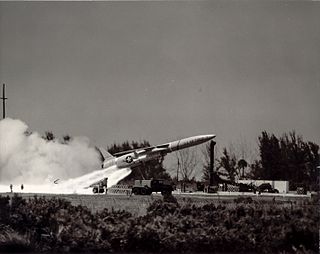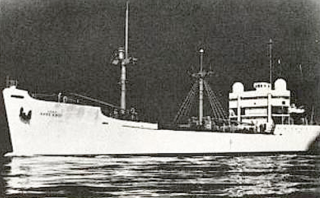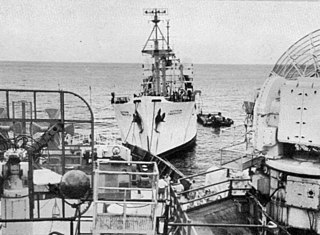
Wake Island is a coral atoll in the Micronesia subregion of the northwestern Pacific Ocean. The atoll is composed of three islets and a reef surrounding a lagoon. The nearest inhabited island is Utirik Atoll in the Marshall Islands, located 592 miles to the southeast. The United States administers Wake Island as an unorganized and unincorporated territory, and it is one of the nine insular areas that comprise the United States Minor Outlying Islands. The Marshall Islands also claim Wake Island.

The Northrop SM-62 Snark is an early-model intercontinental range ground-launched cruise missile that could carry a W39 thermonuclear warhead. The Snark was deployed by the United States Air Force's Strategic Air Command from 1958 through 1961. It represented an important step in weapons technology during the Cold War. The Snark was named by Jack Northrop and took its name from the author Lewis Carroll's character the "snark". The Snark was the only surface-to-surface cruise missile with such a long range that was ever deployed by the U.S. Air Force. Following the deployment of ICBMs, the Snark was rendered obsolete, and it was removed from deployment in 1961.

The PGM-19 Jupiter was the first nuclear armed, medium-range ballistic missile (MRBM) of the United States Air Force (USAF). It was a liquid-propellant rocket using RP-1 fuel and LOX oxidizer, with a single Rocketdyne LR79-NA rocket engine producing 667 kilonewtons (150,000 lbf) of thrust. It was armed with the 1.44 megatons of TNT (6.0 PJ) W49 nuclear warhead. The prime contractor was the Chrysler Corporation.

RAF Ascension Island, also known as Wideawake Airfield or Ascension Island Auxiliary Field, is a military airfield and facility located on Ascension Island in the Atlantic Ocean. The airfield is jointly operated by the Royal Air Force (RAF) and the United States Space Force (USSF). Under the terms of an international agreement between the UK and US governments, only state aircraft are authorised to land at Ascension; however, it is also open to air services between Saint Helena and Ascension.
Pacific Missile Range may refer to:

The Eastern Range (ER) is an American rocket range (Spaceport) that supports missile and rocket launches from the two major launch heads located at Cape Canaveral Space Force Station and the Kennedy Space Center (KSC), Florida. The range has also supported Ariane launches from the Guiana Space Centre as well as launches from the Wallops Flight Facility and other lead ranges. The range also uses instrumentation operated by NASA at Wallops and KSC.
The Downrange Anti-missile Measurement Program or DAMP was an applied research project to obtain scientific data, just prior to and during re-entry, on intermediate- and intercontinental-range ballistic missiles as they returned to earth. The program was funded by the Advanced Research Projects Agency (ARPA) under the technical direction of the Army Ordnance Missile Command (AOMC) during the period 1 January 1959 through 30 September 1963.

USAS American Mariner was a United States Army research vessel from January 1959 to 30 September 1963. She was originally assigned to the DAMP Project by the Advanced Research Projects Agency (ARPA) to attempt to collect radar signature data on incoming intercontinental ballistic missiles in the Caribbean, the South Atlantic Ocean, and the Indian Ocean. Her initial operations involved providing radar track on the Atlas missile, which was under development at the time. Subsequently, she provided track on other types of missiles as they proceeded through their development and operational stages. In September 1963 the original contract was transferred to the USAF until the completion of the testing phase in 1964.
The Missile Test Project (MTP) was a U.S. Air Force program operated by RCA Service Company (RCAS) from Patrick Air Force Base, Florida, under the direction of prime contractor Pan American Guided Missiles Research Division during the 1950s and continuing on for several more decades. Under this program, RCAS instrumented and operated various ships and stations on the Air Force Eastern Test Range with electronic tracking and telemetry equipment. The instrumented ships and stations tracked incoming intercontinental ballistic missiles launched from Cape Canaveral Air Force Station (CCAFS) and, using radar or telemetry, also tracked crewed or uncrewed space vehicles orbiting the Earth.

SS Twin Falls Victory, named after Twin Falls, Idaho, was a Victory ship built for World War II. Converted to a Missile Range Instrumentation Ship, she was initially operated by the US Air Force as USAF Twin Falls Victory, before coming under US Navy control and being named USNS Twin Falls (T-AGM-11/T-AGS-37). She later had a third career as the training ship SS John W. Brown II.
RCA Service Company (RCAS) was headquartered at Cherry Hill, New Jersey, and was a division of RCA created to service appliances and equipment manufactured by RCA.

The Space Launch Delta 45 is a unit of the United States Space Force. The Space Launch Delta 45 is assigned to Space Systems Command and headquartered at Patrick Space Force Base, Florida. The wing also controls Cape Canaveral Space Force Station. The 45th Space Delta is responsible for all space launch operations from the East Coast. It manages the Eastern Range, including launch activities for the Space Force, Department of Defense (DoD), NASA, and other private space corporations.

The United States Air Force's 114th Electromagnetic Warfare Squadron (EWS) is a Florida Air National Guard unit located at Cape Canaveral Space Force Station, Florida. It is operationally gained by the United States Space Force.

Wake Island Airfield is a military air base located on Wake Island, which is known for the Battle of Wake Island during World War II. It is owned by the U.S. Air Force and operated by the 611th Air Support Group. The runway can be used for emergency landings by commercial jetliners flying transpacific routes and has been used in the past by airlines operating jet, turboprop, and prop aircraft on scheduled flights.
Computer Sciences Raytheon (CSR) joint venture partnership of Computer Sciences Corporation and Raytheon Technical Services Company. CSR is the contractor that has managed the Eastern Test Range since 1988. CSR is headquartered at Patrick Space Force Base, Florida.

USNS Sword Knot (T-AGM-13) was a missile range instrumentation ship which operated as USAFS Sword Knot on the United States Air Force's Eastern Range during the late 1950s and early 1960s. Sword Knot operated under an Air Force contract with Pan American Airways Guided Missile Range Division headquartered in Cocoa Beach, Florida.

USNS Rose Knot (T-AGM-14) was a World War II era United States Maritime Commission small cargo ship built in 1945 and delivered to the War Shipping Administration for operation through agent shipping companies and for periods by the Military Sea Transportation Service (MSTS). In 1957 the ship was transferred to the Air Force and converted into a missile range instrumentation ship which operated as USAFS Rose Knot on the U.S. Air Force's Eastern Test Range during the late 1950s and early 1960s. Rose Knot operated under an Air Force contract with Pan American Airways Guided Missile Range Division headquartered in Cocoa Beach, Florida. In July 1964, all Air Force tracking ships were transferred to MSTS for operation with the Air Force in operational control while the ships were at sea as tracking ships. Rose Knot had special facilities for supporting the human spaceflight program and supported the early crewed flights. The ship was owned by the U.S. government until sold for non-transportation use in 1977.

USNS Timber Hitch (T-AGM-17) was a US Navy missile range instrumentation ship which earlier operated as the US Air Force Ocean Range VesselUSAFS Timber Hitch (ORV-17) on the US Air Force's Eastern Test Range during the late 1950s and early 1960s. Timber Hitch operated under an Air Force contract with Pan American Airways Guided Missile Range Division headquartered in Cocoa Beach, Florida.
USNS Sampan Hitch (T-AGM-18) was a missile range instrumentation ship which earlier operated as the U.S. Air Force Ocean Range VesselUSAFS Sampan Hitch (ORV-1836) on the U.S. Air Force's Eastern Test Range during the late 1950s and early 1960s. Sampan Hitch operated under an Air Force contract with Pan American Airways Guided Missile Range Division headquartered in Cocoa Beach, Florida.
The Missile Impact Location System or Missile Impact Locating System (MILS) is an ocean acoustic system designed to locate the impact position of test missile nose cones at the ocean's surface and then the position of the cone itself for recovery from the ocean bottom. The systems were installed in the missile test ranges managed by the U.S. Air Force.